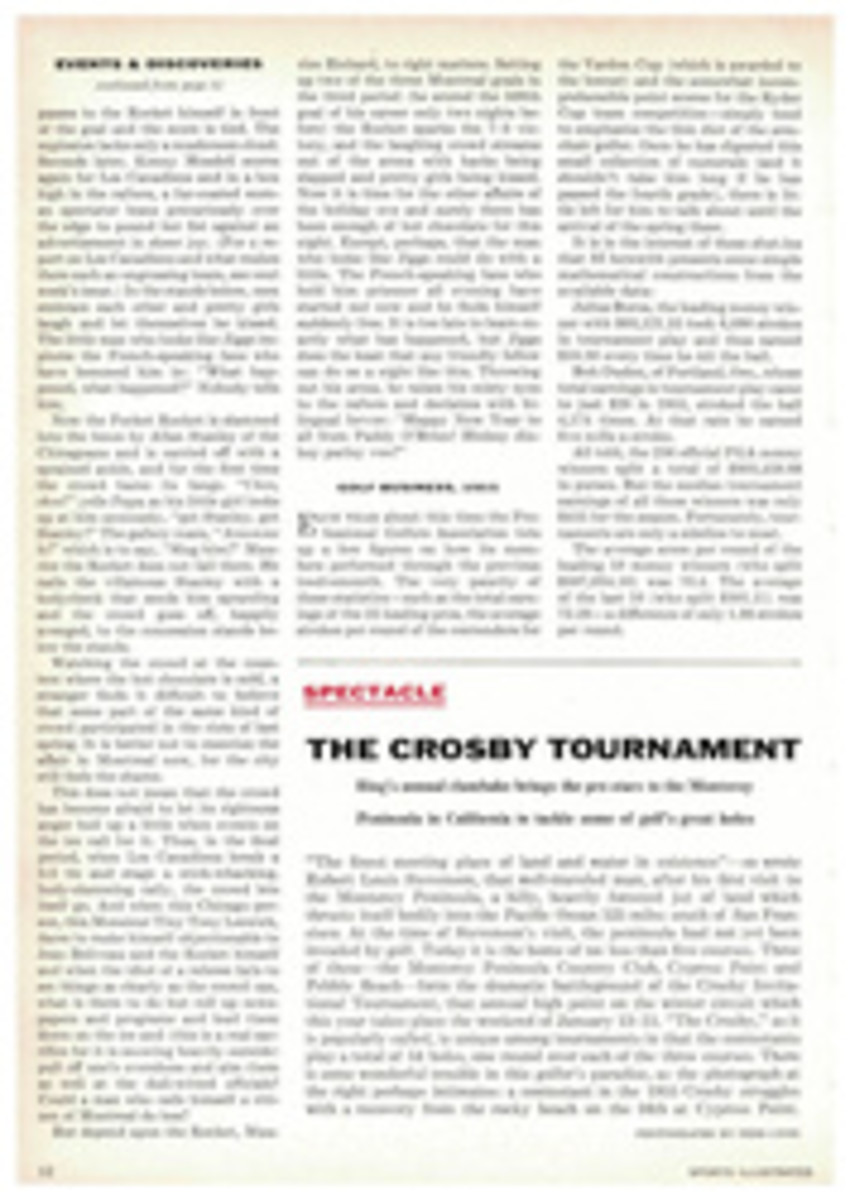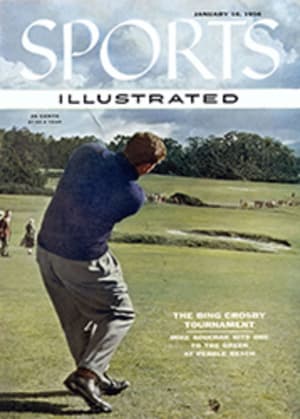
AFTER WATCHING THE GAME AND ANALYZING THE FILMS, SI'S EXPERT EXPLAINS WHY OKLAHOMA IS INDEED NATION'S TOP TEAM
The far-flung spectacle of the bowl games over the New Year weekend, with their drama, triumph and tragedy, tempts me to review them from the vantage point of a theater critic on opening night. In this mood, it might be said that Spartacus to the Uclans, though acclaimed by coast critics as a great dramatic success, must be considered as cheap melodramatic theater. The finale was completely implausible—it could never have happened in real life—and the lines were overplayed. Off-stage direction was accompanied by wild gesticulations and the prompter was audible to the audience at various times. Nonetheless, in all fairness and despite the script, the results were electrifying. It must be admitted that Producer H. Duffy Daugherty has a hit on his hands after his first dismal flop a year ago.
By contrast, the revival of Oklahoma down in Miami was an artistic and technical triumph. Polished performers were cast perfectly by Producer Charles B. Wilkinson, who now has a near-record string of 30 straight hits. The action was classic and the lines were powerful and well delivered. The original vehicle, written by the veteran Don Faurot, has lost none of its freshness or strength through the years. Oklahoma was undoubtedly the best production of this past season. In fact, to revert to the solid ground of football terms once more, I think that, all in all, Oklahoma's playing clearly established its right to be considered the nation's outstanding 11.
When two teams as strong defensively as the Terps and the Sooners meet, there is little chance of spectacular offensive play. Both Jim Tatum and Bud Wilkinson are definitely defense-minded, and this carries over into their theory of offense where, by controlling the ball for a longer period than their opponents, they plan to lessen the number of their opponent's plays from scrimmage.
This certainly is a radical change from the thinking of the three master defensive strategists of another era: Fielding Yost of Michigan, Wallace Wade of Alabama and Duke and Bob Neyland of Tennessee. These three never wanted possession of the ball in their own territory. By using an airtight kicking game in all its phases they managed to keep their opponents floundering deep in "coffin corner," where sooner or later an offensive error would be committed which usually cost them six points.
Then along came the T formation with its flankers and man in motion; the "race horse" game began its era, and "Give us the ball anywhere" was the cry. By 1950 the wide-open game began to wane except in the professional ranks as teams everywhere started adopting the newfangled split-T. Innovator Don Faurot and his two ardent disciples, Wilkinson and Tatum, toured the hinterlands preaching the doctrine of simplicity—"only four basic plays to each side"—and control football. Their mark is indelible. Even down in the Southwest, the home of the aerial circus, football today is preponderantly a ground game. Because it is, the pass—when used—almost always surprises, and consequently is more dangerous than ever.
All this was evident in the Orange Bowl, particularly in Wilkinson's use of the fast break—a maneuver as conservative and as dynamically precise as close order drill. It was exploited the first time Oklahoma got the ball in the second half, and it completely demoralized the hitherto impregnable Maryland defenses. The Sooners were fast out of the huddle, down in position like a flash, and the ball was snapped on a quick count as the Sooner linemen fired out on the still squatting Terp forwards. Each back ran with reckless abandon. And always, when tackled, they had in reserve a second surge which picked up an extra yard or two.
The fast break carried the Sooners through two straight touchdown drives. In neither did they give up the ball, and they disdained the use of the forward pass except on just one occasion. In a critical moment of the first drive, Quarterback Harris pitched out to Left Half McDonald, running to his right, who hit Right Half Burris for a 19-yard gain to the Maryland seven. Two plays later Oklahoma scored.
Bud Wilkinson felt this pass play (see opposite page) was the turning point of the game. After these two unstoppable drives and two successful tries for extra points and with the score standing at 14-6 (Maryland had its try for point blocked), the game to all intents and purposes was over. The Sooners later added a gift touchdown on an 82-yard run with an intercepted pass.
Maryland, too, had its moments and heroes. Ed Vereb, the Terps' left half, was the outstanding player in the game. He made the longest run from scrimmage (66 yards), only to have it dissipated by a teammate's fumble on the five-yard line, and pulled off a 15-yard run for a touchdown as he reversed his field on what looked like a running pass to the right. After studying the game pictures I'm not so sure that it wasn't a planned maneuver. In any case, it was a designed alternate if the pass wasn't open.
Pellegrini and Davis made the key blocks on this, the prettiest play of the day. Mike Sandusky played an outstanding game at tackle and should be nicknamed Ali Baba, the Thief of Bagdad, because he was trying to steal the ball all day from the Oklahoma backs. Pellegrini, though badly battered, backed up the line with authority and thwarted another Oklahoma touchdown by an interception in the waning moments of the game. In behalf of Tatum, the losing coach, it should be said that he might well have been the winner if he had gone into the second half with a two-touchdown lead. This probably would have happened except for Tamburello's fumble on the five. Oklahoma was beginning to show signs of jitteryness late in the second quarter.
Still, credit where credit is due. Wilkinson must have done a whale of a job during the extended 20-minute half time. The lethargic first-half Sooners were reincarnated when the third quarter started. In the final analysis, speed was the difference both up front and in the backfield. If you think the Sooners were good this past season, just wait until this fall.
TWO PHOTOS
DIAGRAM
15
25
43
40
HICKMAN'S HUNCHES, 1955
Season's average: .748
Five bowls: .800
HICKMAN'S HUNCHES, 1956
Four bowls: 1.000
KEYS TO VICTORY AS SEEN ON FILM
THE FAST BREAK
The second half of the game saw the Oklahoma line unleash its full power and speed. As these clips from the official Maryland movie show, the Sooners' fast break from the huddle, their quick snap of the ball and lightninglike charge repeatedly caught Maryland's forwards off-balance and thrust the whole line back four to five yards. Here the second team goes into action in the third period, after the Sooners' first touchdown. Quarterback Jay O'Neal (17) takes the ball (top), with the team in split-T formation. He takes a few steps to his right as the Sooners' line and backfield charge, then dives between right guard and tackle as hole opens well beyond line of scrimmage.
THE CRITICAL PASS
It was the play diagramed in SI's bowl games preview (above), which, in the words of Bud Wilkinson, was the turning point of the game. In the third quarter, Quarterback Jim Harris (15) faked (top) to Fullback Billy Pricer, then pitched back to Left Half Tommy McDonald (25). McDonald (second picture) passed to Right Half Bob Burris (40), who had gone through the line and cut to his right. The third picture shows the ball in midair; the fourth at the instant when Burris caught it. In the fifth, Burris is seen thwarting a tackle with a hard shoulder block. Terp Center Bob Pellegrini (50) is close behind (sixth picture) and makes the tackle at Maryland's seven (seventh picture). From here the Sooners went on to their first touchdown.

